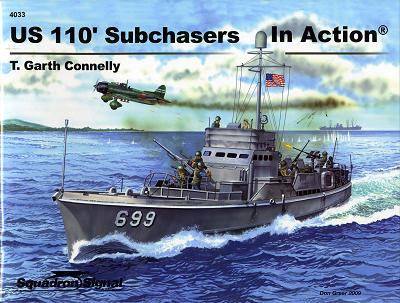|
Title: |
US 110' Subchasers In Action |
|
Author: |
T. Garth Connelly |
|
Publisher |
Squadron/Signal
Publications |
|
Price |
$14.95 MSRP |
|
Reviewer: |
Scott Van Aken
|
|
Notes: |
#4033, ISBN: 978-0-89747-587-7 |
 We all
know that the United States has been a major naval power since just before the
turn of the 20th Century. In both World Wars, its various shipyards launched
literally thousands of vessels of all sizes and capabilities to help in the war
effort. We all recall and read avidly about the aircraft carriers, battleships
and cruisers, but these were really just a small percentage of what was built.
Amongst the smaller of the the ships, but nonetheless an important part of the
fleet were the patrol craft/subchasers.
We all
know that the United States has been a major naval power since just before the
turn of the 20th Century. In both World Wars, its various shipyards launched
literally thousands of vessels of all sizes and capabilities to help in the war
effort. We all recall and read avidly about the aircraft carriers, battleships
and cruisers, but these were really just a small percentage of what was built.
Amongst the smaller of the the ships, but nonetheless an important part of the
fleet were the patrol craft/subchasers.
In both wars these small vessels were
instrumental in helping to protect coastal waterways and even to assist in
convoy protection, though they really were not meant for operation in the open
seas. Though a variety of designs were submitted the ones that were chosen were
110 feet in length with crews around a dozen or so officers and men.
A 120 foot version was recommended in a 1937 study, but apparently never built.
The book states that many of these ships were mostly crewed by Naval Reserve types whose officers were, for
the most part, playboy yachtsmen and so they had a bit of an attitude to go
along with serving in these wooden ships. Yep, these were mostly crafted of wood
in smaller shipyards that specialized in wooden boat construction. Thanks to
their simple design and the skilled workmen who built them, the average time
from start to outfitting was around 60 days or so, with some being launched in
less time than that. Though not heavily armed, they did have a decent
sized deck gun and depth charges so were able to keep submarines at bay. Their
leisurely speed compared to other combat ships was more than sufficient to escort slow
transports or chase even slower submarines.
In this latest In Action book, we are given the
history of the various types of subchasers built along with detailed information
on their layout, power plant, weapons and other aspects of the ship. There is
also a smaller section on their action in both the Atlantic, Mediterranean, and
Pacific theaters. You'd have thought there would be more to their battle
history, but apparently these were more of the 'preventive' type of ships and
didn't really see all that much actual combat. There are the usual copious
photographs of all the different variants and color schemes. Seemingly all of
the photos were taken in US waters so apparently they were not heavily
photographed in action. We also have a copious number of images of the various
details of these small ships, surely something that will interest the modeler.
Overall, a fine book on an often overlooked
vessel. I'm sure naval enthusiasts will be pleased with it and the rest of us
will find it to be a most interesting diversion from the norm. A book that I can
easily recommend to you.
July 2009
My thanks to
www.squadron.com for providing the review book. Get yours today at your
local shop or on-line retailer.
If you would like your product reviewed fairly and quickly , please contact
me or see other details in the Note to
Contributors.
 We all
know that the United States has been a major naval power since just before the
turn of the 20th Century. In both World Wars, its various shipyards launched
literally thousands of vessels of all sizes and capabilities to help in the war
effort. We all recall and read avidly about the aircraft carriers, battleships
and cruisers, but these were really just a small percentage of what was built.
Amongst the smaller of the the ships, but nonetheless an important part of the
fleet were the patrol craft/subchasers.
We all
know that the United States has been a major naval power since just before the
turn of the 20th Century. In both World Wars, its various shipyards launched
literally thousands of vessels of all sizes and capabilities to help in the war
effort. We all recall and read avidly about the aircraft carriers, battleships
and cruisers, but these were really just a small percentage of what was built.
Amongst the smaller of the the ships, but nonetheless an important part of the
fleet were the patrol craft/subchasers.